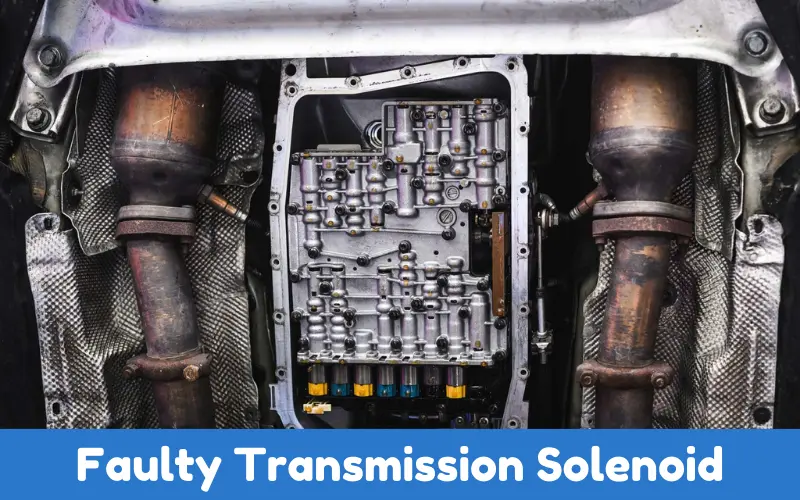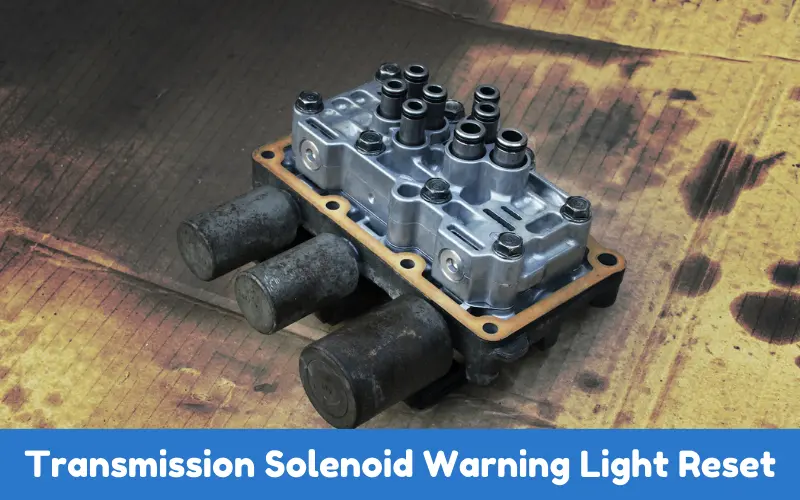The transmission system consists of various components, including the transmission solenoid. This part regulates the quantity of transmission fluid and allows smooth gear shifting.
A transmission solenoid warning light reset is a must if the warning light appears. It represents a major transmission system issue that could flash on your dashboard.
Here, we explore why this happens, how to reset it, and when to see an expert.
Article Summary
- What Does Transmission Solenoid Warning Light Mean?
- Understanding the Transmission Solenoid Warning Light
- Steps To Transmission Solenoid Warning Light Reset
- What is the Cost of Transmission Solenoid Replacement?
- What To Do If Transmission Slips When the Cold?
- FAQs on Transmission Solenoid Warning Light Reset
- What Does the Transmission Solenoid Warning Light Indicate?
- How Can I Reset the Transmission Solenoid Warning Light?
- What Should I Do If the Warning Light Comes Back on After Resetting?
- Can I Reset the Warning Light Without Fixing the Underlying Issue?
- Is It Safe To Drive with the Transmission Solenoid Warning Light on?
- Conclusion
What Does Transmission Solenoid Warning Light Mean?
The transmission solenoid in your vehicle lights up due to a malfunction that identifies potential problems with the transmission system.
This light may ignite for multiple reasons, like defective transmission solenoid, low or contaminated transmission oil, overheating, or some issues with related sensors. The solenoid controls the flow of transmission fluid, which is critical for smooth gear shifts.
When the light comes on, it can indicate a transmission that’s not operating at peak performance, which in turn means poor fuel economy, possible gear slipping, delayed gear shifts, and other performance problems.
However, ignoring warning signs can result in more serious damage, so the repair cost shall certainly increase.
Thus, to overcome this illuminated malfunction indicator, you might need to check the transmission fluid level (by popping the hood), have a look for transmission fluid leaks (by inspecting the ground area), or take your vehicle to a mechanic, provided the illumination continues even after due care of removing the obvious problems.
Undoubtedly, performing scheduled maintenance activities can greatly aid in alleviating such issues with your car’s transmission.
Understanding the Transmission Solenoid Warning Light
Before we get to the reset procedure, some background would be helpful. The transmission solenoid warning light can mean one of three things:

- Faulty Transmission Solenoid: This can occur due to wear and tear or electrical issues.
- Transmission Fluid Problem: The light pops on when fluid is low or contaminated.
- Transmission Overheating: Excessive heat can lead to the solenoid malfunctioning.
- Sensor Malfunction: Issues with other transmission sensors may also trigger this warning.
However, climate, weather conditions, and the behavior of us urban bipeds need to be at their best for the process to run smoothly.
That’s why it’s dangerously negligent and short-sighted to ignore the warning light that indicates transmission problems and postpone repairs.
Steps To Transmission Solenoid Warning Light Reset
Here’s a step by step guide to help you reset the transmission solenoid warning light:
1. Check Transmission Fluid Levels
- Open the hood and locate the transmission fluid dipstick.
- Pull it out, wipe it clean, and reinsert it.
- Check the fluid level. If it’s low, add the manufacturer recommended fluid.
2. Inspect For Leaks
- Check under the vehicle for transmission fluid leaks. If there are puddles, fix the leak before continuing.
3. Disconnect the Battery

- Shut down your vehicle. Unhook the negative terminal of the battery. This empties the vehicle’s computer memory, potentially physically erasing minor error codes.
- Wait for about 10 to 15 minutes before reconnecting the battery.
4. Reconnect the Battery
- Reattach the negative terminal to the battery and tighten it securely.
5. Start the Vehicle
- Turn the ignition to the “On” position without starting the engine.
- Wait 30 seconds or so, and then start the car. Check to see if the transmission solenoid warning light is on.
6. Drive the Vehicle
See if the light will reset itself. A short drive should do the trick.
What is the Cost of Transmission Solenoid Replacement?
The expected cost of a transmission solenoid replacement depends on several factors, including the car or truck model make, the place of repair, and whether the part, OEM or aftermarket, is original or rebuilt.
Replacing a single transmission solenoid will likely cost an average of between $150 to $400.
They cost about $75 to $150 an hour, and it will generally take 2 to 4 hours of labor, so the total cost can be $150 to $600 depending on your car’s make if you need more than one solenoid replaced or additional repairs, the cost could be far higher, sometimes as much as $1,000 or more.
Obtain several quotes from different repair shops to ensure you get a fair price. Also, regular maintenance will help you avoid anything that may lead to the need for solenoid replacement and save you big money in the long run.
What To Do If Transmission Slips When the Cold?
Experiencing slippage in the transmission when your vehicle is cold is probably something you never want to experience, especially if it indicates something more substantive going wrong with the transmission itself.
Essentially, this is when the transmission, for instance, doesn’t engage when you thought it had or downshifts you at the wrong time, most often when you start from cold and drive for the first 10 to 15 minutes.
Dirty fluid from being low or filthy is the leading cause: when the fluid is low or coated with debris, the transmission won’t operate as efficiently. The fluid can become thick and slow across gears when it’s cold.
Furthermore, transmission slips can be caused by internal problems such as faulty transmission solenoids, which control fluid flow, or rough shifting caused by worn or damaged parts such as gears or clutches.
If the slipping is caused when the car is cold and goes away after it warms up, this is usually a sign of a dirty fluid or a problem with one of the components.
This can be remedied by checking your transmission fluid level and condition. A change is needed if it is too low or dirty.
If it continues, you should see a qualified mechanic for diagnostics and repair to ensure proper operation in all weather conditions and temperatures. Routine maintenance can help to avoid these problems altogether.
When To Seek Professional Help?
If the warning light is still on after following the steps above, there may be an issue with the transmission or the solenoids (see below). Signs that you should see a professional mechanic:

- Slipping Gears: If your car feels like it’s about to slip out of gear or if it suddenly does slip out of gear.
- Unusual Noises: Grinding, whining, or clunking noises when shifting.
- Fluid Leaks: Any visible signs of leaking transmission fluid.
- Poor Acceleration: If you notice a significant loss in power or acceleration.
FAQs on Transmission Solenoid Warning Light Reset
What Does the Transmission Solenoid Warning Light Indicate?
A light labeled transmission solenoid warning indicates that your vehicle has a problem with its transmission system, which might be a faulty solenoid, transmission fluid that is either low or contaminated, or overheating in the transmission system. It is important to sort it out quickly as this warning light would further cause damage to your vehicle if not taken seriously.
How Can I Reset the Transmission Solenoid Warning Light?
Start by checking the transmission fluid and adding more if necessary. Then, unhook the negative battery terminal for approximate 10 to 15 minutes so the computer can reset itself, then hook it back up and start the vehicle. Drive and see if the light remains off.
What Should I Do If the Warning Light Comes Back on After Resetting?
Resetting the warning might mean that all is now well, or it might simply be a sign of a serious problem with the transmission. If the light comes back on, contact an expert immediately to figure out the diagnosis and any necessary repairs. But the light can indicate more serious transmission troubles. It’s wiser to replace the transmission via your local mechanic than to ignore the issue until it’s too late.
Can I Reset the Warning Light Without Fixing the Underlying Issue?
You can reset the warning light, but when the ‘historical years’ are filled with a check engine light, your vehicle will fall apart by the roadside. Since you repaired the root cause of the problem, you prevented more costly repairs.
Is It Safe To Drive with the Transmission Solenoid Warning Light on?
If you see the transmission solenoid warning light on, slipping gears or loss of power could result if you keep driving. Bring it in for service to avoid an accident or breaking down.
Conclusion
Resetting the transmission solenoid warning light is a simple matter in most cases. If the problem is minor, you can simply reset the light without issue and avoid unnecessary repairs.
On the other hand, if the light continues to come on no matter how many times you reset it, you shouldn’t ignore it.
See a professional to make sure there isn’t more serious damage to your vehicle. Good maintenance habits can go a long way.
You should check your transmission fluid levels to ensure they’re not too high or too low, and keep an eye out for leaks.

